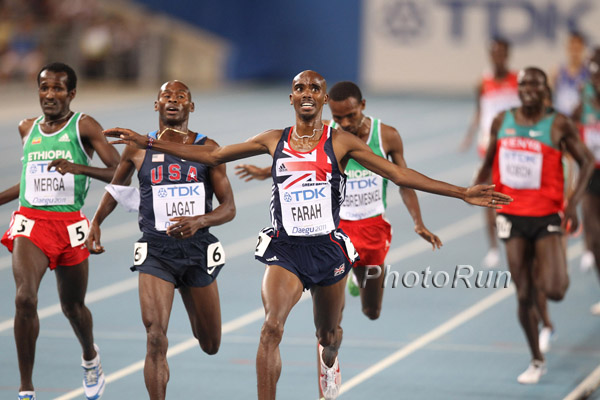 Mo Farah, 2011 WC 5,000m, gold medalist, (photo from 10,000m), photo by PhotoRun.net
Mo Farah, 2011 WC 5,000m, gold medalist, (photo from 10,000m), photo by PhotoRun.net
The story of the 5,000 meters started a week ago, when Mo Farah was caught by Ibrahim Jeilan in the final meters of the race. While Farah took the silver, the first by a British runner in the World Champs, the British media were considering the race a let-down, as if a medal was a foregone conclusion. In distance running, there are no foregone conclusions, one must earn the medals in the 5,000m and 10,000m-there are no free rides
here.
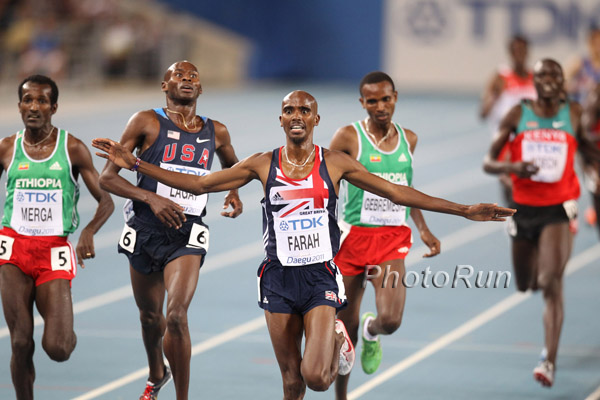 2011 WC 5,000m final: Merga, Lagat, Farah, Gebremsekel, Koech, photo by PhotoRun.net
2011 WC 5,000m final: Merga, Lagat, Farah, Gebremsekel, Koech, photo by PhotoRun.net
The fact of the matter is this: In the 5,000m as well as the 10,000m, just about anyone in the final can win. And there are always surprises.
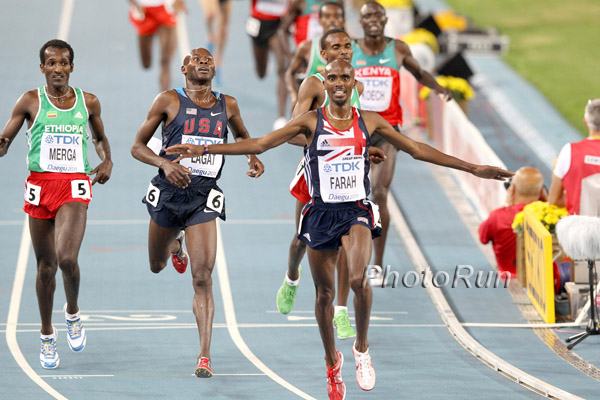 2011 WC 5,000m final: Merga, Lagat, Farah, Gebremsekel, Koech, photo by PhotoRun.net
2011 WC 5,000m final: Merga, Lagat, Farah, Gebremsekel, Koech, photo by PhotoRun.net
The tactics of Mo Farah in this 5,000m final need to be understood from the experience of his 10,000 meter race earlier in the World Championships.
Farah knew that he had one chance in the 5,000 meters to take the race, and that was getting a few meters on Lagat’s kick, which would require all of his racing skills. In that way, the 5,000 meter victory would be much, much harder than the 10,000 meters.
This is how we saw the race:
(updated September 7, 2011)

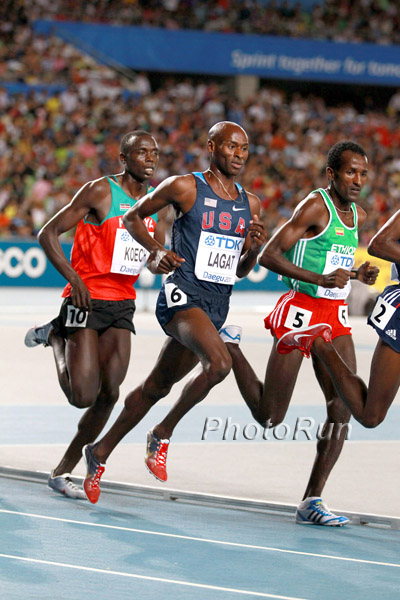 Bernard Lagat, 2011 WC 5,000m, silver medalist, photo by PhotoRun.net
Bernard Lagat, 2011 WC 5,000m, silver medalist, photo by PhotoRun.netAbera Kuma, Imane Merga, both of Ethiopia, were lurking near the front. Kuma took the field through 2,000 meters in 5:35.6, a 2:45 1,000 meters. Rupp and Farah were mid pack,with Lagat right behind.
Hussain Alhamdah was the guy who started picking it up, just after six laps. He dropped a 63.1, then a 62.4, and hit the 3,000 meters in 8:13.7. Almadah, from Saudi Arabia, continued to push the pace.
Rupp was on the outside, with Farah right behind him. Behind Almadah was Merga, Kuma, Koech, Kipchoge, Dejan Gebremeskel, and Isaih Koech. The pace was quickening, as they passed the 4,000m mark in 10:55.6. Leading at the 4k mark was none other than Ethiopian Abera Kuma.
The race was getting physical. Imane Merga cut off Mo Farah more than once in the third kilometer, but Farah stayed focused. Lagat had moved up to just behind Farah and Rupp was just behind the leaders. Rupp had taken the lead just before 4,000 meters. In fact, Galen had been up front most of the race, pushing the pace when it needed, looking for a chance to steal the race.
At 4,000 meters, Mo Farah got up close to the lead, but did not lead. The pace started to quicken, as the penultimate lap was run in just around 62, and then Mo Farah, who was on the inside, and Merga on the outside, hit the bell at 12:28. Farah knew he had to time his kick with perfection. Lagat was there, menacing. He would be the toughest one to hold off, and Farah knew that.
Farah, who had learnt from his 10,000m race, began to move with 500 meters to go, but not pushing it, yet. He increased the pace with 300 meters to go, but still, saved a bit. When Farah hit the 200 meter mark, he was in full sprint, with Lagat, Merga, Gebremeskel and Koech following. Kuma fell off the back as did Rupp.
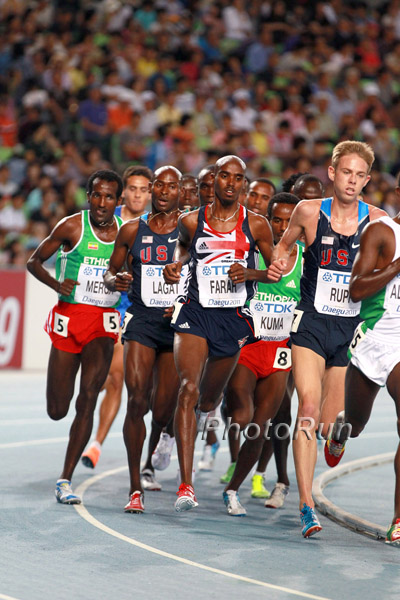 Rupp, Farah, Lagat, 2011 WC 5,000m final, photo by PhotoRun.net
Rupp, Farah, Lagat, 2011 WC 5,000m final, photo by PhotoRun.net
Around the final turn, Farah was starting to accelerate, Merga was kicking, and Lagat was starting to take off. Had Farah waited too long?
It is at this time, that the race is decided. A year’s worth of training, a life time of dreaming, settled over 80 meters. This is Lagat’s world. This is the world that Farah has to inhabit, has to, in fact, own, if he is to become a world champion. Does he have it? Can Mo Farah take on the best kicker in the world? Bernard Lagat is at the top of his game. Merga is not a lightweight either. Merga can kick with the best of them. Merga could, in fact, have inhabited the world of Roller Derby: he has not seen a push or shove he does not like in a distance race.
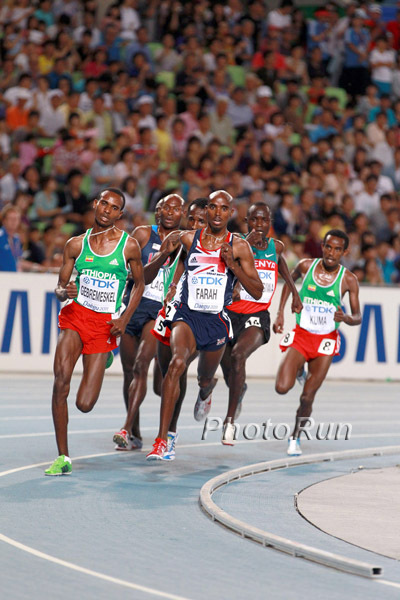 Farah, with 350 meters to go, 2011 WC 5,000m, final, photo by PhotoRun.net
Farah, with 350 meters to go, 2011 WC 5,000m, final, photo by PhotoRun.net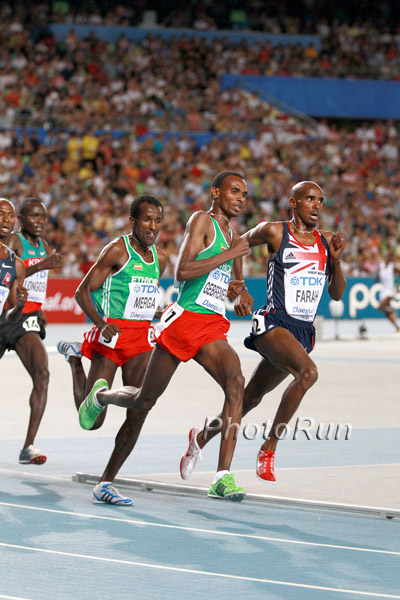 Race on! 2011 WC 5,000m, photo by PhotoRun.net
Race on! 2011 WC 5,000m, photo by PhotoRun.net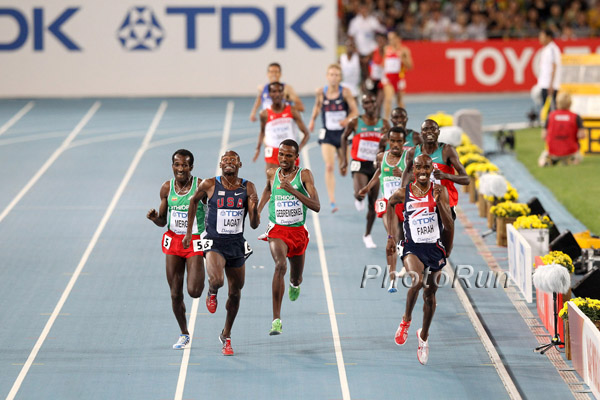 Did he wait too long? Farah Kicks, Lagat Gains, 2011 WC 5,000m, photo by PhotoRun.net
Did he wait too long? Farah Kicks, Lagat Gains, 2011 WC 5,000m, photo by PhotoRun.net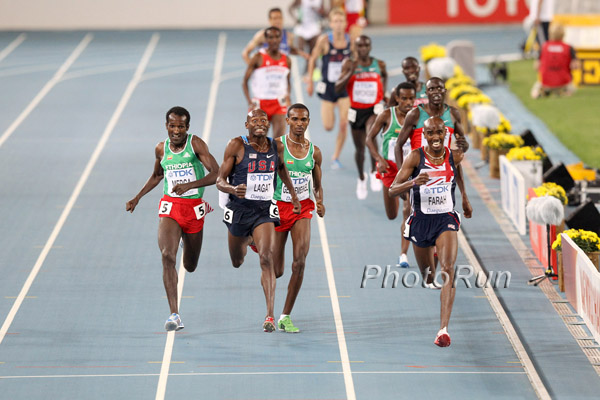 The final strides, Merga, Lagat, Farah, 2011 WC 5,000m, photo by PhotoRun.net
The final strides, Merga, Lagat, Farah, 2011 WC 5,000m, photo by PhotoRun.net
straightaway, Mo Farah jumped on it, and started to open five, maybe six
meters on Lagat, who was just about to pounce. First Lagat passed
Merga, then Bernard Lagat started to kick. Mo Farah held it together
until about fifty meters and then just let loose running for the finish,
and hoping to hold off Lagat.
As Lagat kicked past Merga and
Gebremeskel, he moved closer to Mo Farah, but it was not to be, Lagat
was taking the silver, as he had in 2009.
Mo Farah had his first gold medal,
hitting the tape in 13:23.36, with Bernard Lagat taking the silver in
13:23.64, and Imane Merga taking the bronze in 13:23.78.
In fact, Merga was disqualified for running in the infield, (Imane Merga, ETH, DQ (rule 163.3b, running in the infield) in the latter stages of the race, and Dejan Gebremeskel took the bronze, running 13:23.92. (updated September 7, 2011)
In fourth, Isaih Koech of Kenya ran 13:24.95 and Abera Kuma of Ethiopia was fifth in 13:25.50.
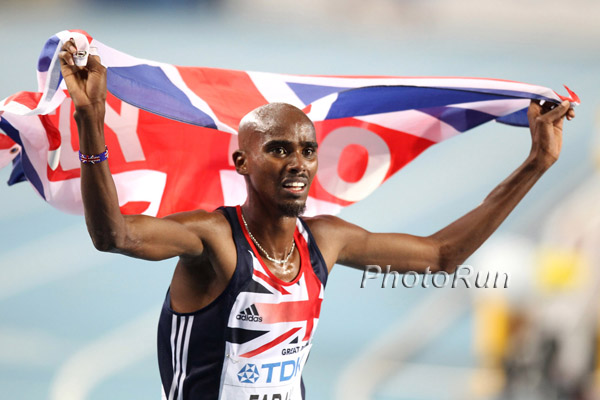 Mo Farah, 2011 WC 5,000m gold, photo by PhotoRun.net
Mo Farah, 2011 WC 5,000m gold, photo by PhotoRun.net
Thomas Longosiwas of Kenya was sixth in 13:26.73. In tenth, Galen Rupp ran 13:28.64.
The final kilometer had taken 2:28, but the final lap was in mid 52 seconds and the last two hundred meters was 26.2-26.6 for the leaders. The race was won and lost in the last 80 meters, the world of Bernard Lagat, who had taken the silver in 2009 and won in 2007. This race was no cake walk.
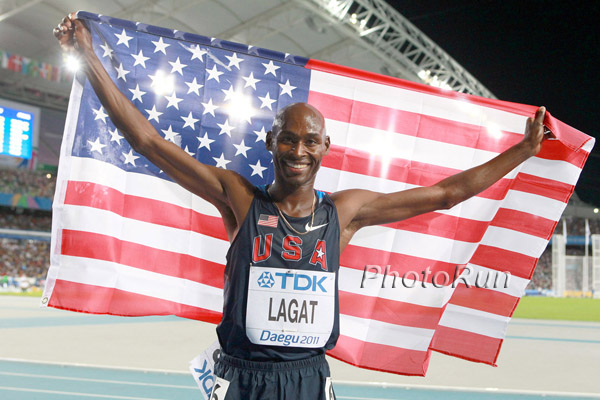 Bernard Lagat, 2011 WC 5,000m, silver, photo by PhotoRun.net
Bernard Lagat, 2011 WC 5,000m, silver, photo by PhotoRun.net
What Mo Farah did was give himself enough room to get some living space between him and Bernard Lagat’s fearsome kick. Mo Farah had not only held off Bernard Lagat, he had taken the gold in the 5,000 meters, a race so different from the 10,000m, yet, so similar. He had taken a hard learnt lesson and used it over 12 1/2 laps, where a mistake in starting a kick or finish is even more severely punished than in the 10,000 meters. Coach Salazar should be very proud.
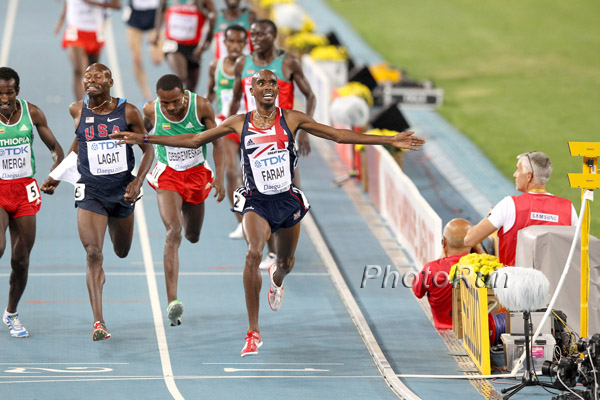 the final steps, 2011 WC 5,000m final, photo by PhotoRun.net
the final steps, 2011 WC 5,000m final, photo by PhotoRun.net
Bernard Lagat, the silver medalist told the assembled media, ” Mo works hard. Yes, he is one of the best runners in the world right now, one of the strongest athletes out there. To be honest, I was cheering for Mo in the 10k, screaming for Mo to win, and you want your friends to win. We did not train together, but we would see each other after training (in Flagstaff).”
Mo Farah now has his gold medal and his silver medal. He is poised for London 2012 and his coming out party was in Daegu. He will be a huge force to be reckoned with in London.
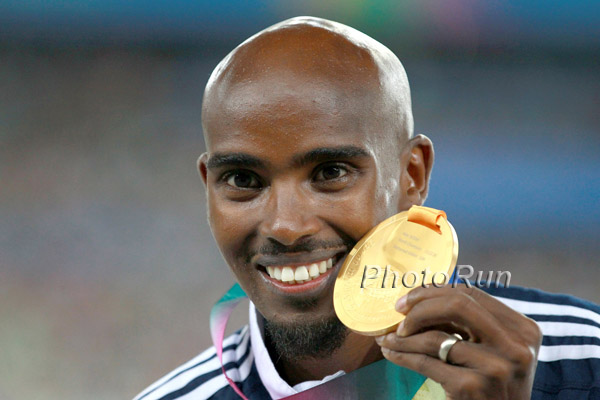 Mo Farah and his gold medal, 2011 WC 5,000m final, photo by PhotoRun.net
Mo Farah and his gold medal, 2011 WC 5,000m final, photo by PhotoRun.net
Updated September 6, 2011

Author

Larry Eder has had a 52-year involvement in the sport of athletics. Larry has experienced the sport as an athlete, coach, magazine publisher, and now, journalist and blogger. His first article, on Don Bowden, America's first sub-4 minute miler, was published in RW in 1983. Larry has published several magazines on athletics, from American Athletics to the U.S. version of Spikes magazine. He currently manages the content and marketing development of the RunningNetwork, The Shoe Addicts, and RunBlogRun. Of RunBlogRun, his daily pilgrimage with the sport, Larry says: "I have to admit, I love traveling to far away meets, writing about the sport I love, and the athletes I respect, for my readers at runblogrun.com, the most of anything I have ever done, except, maybe running itself." Also does some updates for BBC Sports at key events, which he truly enjoys. Theme song: Greg Allman, " I'm no Angel."
View all posts


















